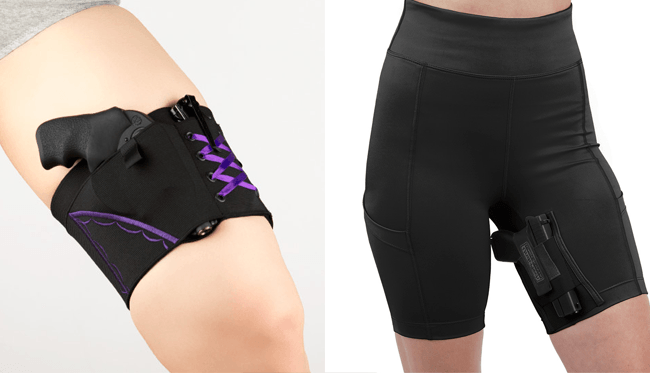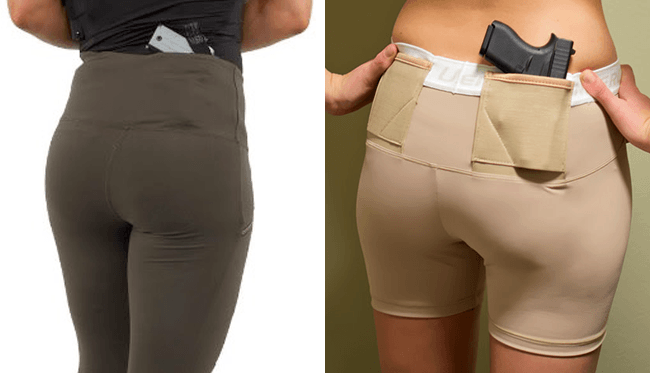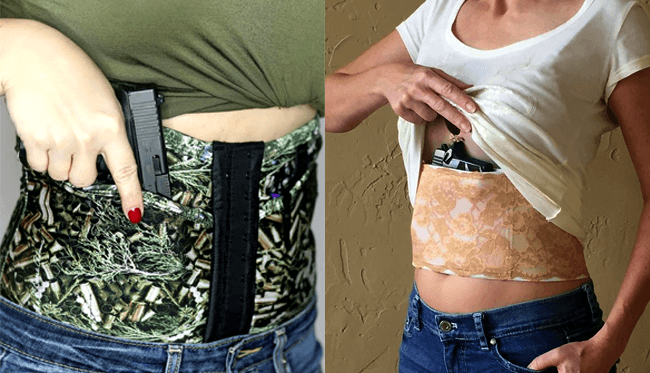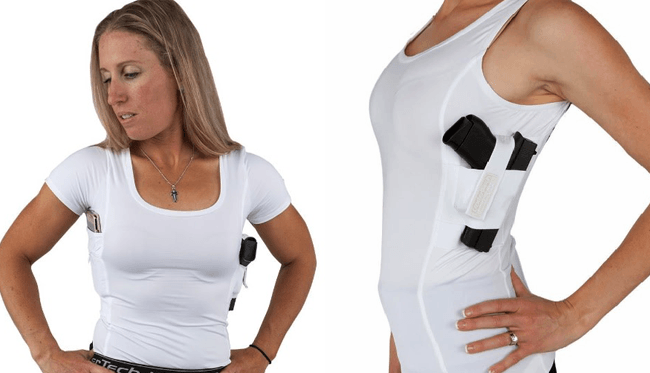On-Body Concealed Carry for Women: Specialty Holsters
By Eve Flanigan
In the first of this two-part series, the most common methods of on-body carry for women were discussed. Many women choose those methods because they keep the concealed handgun relatively easy to access, not to mention the dozens of holster choices designed for carrying around the body’s midline. But for lots of other reasons, particularly the desire for more discreet concealment, many women seek out what might be called “specialty holsters,”
The motivation to adopt a holster that conceals deeper is usually sought for one of two reasons: detection avoidance or fashion. Regarding the first, the consequences of having one’s armed status discovered at work can be detrimental, even where concealed carry is legal, and part of the reason we carry concealed is because the element of surprise is in our favor should such a situation warrant drawing and presenting a firearm in self-defense. Other women might be determined to carry but equally determined to not compromise the ability to wear form-fitting attire around the midsection. For these and other reasons, specialty holsters can be problem-solvers. Let’s look at three of the most popular designs:
Undergarment-Based Holsters
In this category are undershirts, tank tops, corsets, bellybands, and bra-attachment holsters and, to my knowledge, one other product that’s made in the shape of a wide, rolled bandage that can be fashioned around the midsection however creatively one needs in order to accommodate safe carry.
When worn low enough, holster-corsets and elasticized bellybands made for concealed carry also fit into the inside-waistband (IWB) category, but without requiring a belt. Some corsets are especially good at printing avoidance, since the trigger guard, grip and business end of the firearm are all enclosed in fabric. The compromises here will be the time required to draw, labor required to re-holster and the feeling of being squeezed all day.
These around-the-torso holsters should be worn sufficiently snug to keep the gun from shifting around, as your carry gun should be at one reliable place on the body at all times. Especially for a woman with a “V” or hourglass-shaped torso, it’s likely that that band will need to be quite tight to stay in place. Worn for eight or more hours, this can potentially impede digestion. It’s best to experiment, adjusting, removing and changing around the holster’s position in the privacy of home and wearing for short time spans, before committing to full-time wear.
Undershirt and tank-top-style holsters can offer excellent concealment and usually cover all safety concerns as well. However, these designs are subject to the same time-consuming draw limitations as torso wrap-type holsters.
Because re-holstering with both these systems can be a laborious and sometimes immodest process, you’ll need to commit to practice. Depending on your range setting and rules, this practice may best be reserved for dry-fire — meaning no ammunition in the same room — at home.
There is a holster brand that clamps to the fabric between the two wires of an underwire bra. With a small handgun enclosed inside its hard clamshell design, the holster meets safety requirements. Larger-breasted women can conceal especially well with these systems. The downside is that gun maintenance must be diligently practiced, as with any holster that allows sweat to be in contact with metal. Even though the firearm may be mostly polymer, it’s surprising how much sweat can creep in and onto steel, resulting in rust and, if woefully neglected, a non-functional firearm.
Thigh Systems
Thigh holsters made of neoprene or pliable leather can offer great concealment under dresses or loose slacks. As with ankle carry, the most discreet location for the gun is on the medial side of the support-side leg. For example, a right-handed shooter would wear the wrap on her upper left thigh. Thigh holsters can become loose or abrasive with physical activity and are therefore mostly suitable for sedentary times.

Left: Garter Holster from Can Can Concealment. Right: Concealment compression shorts from Undertech Undercover
Remember that while neoprene is soft and non-abrasive, heat and sweat will build up under the holster regardless of its location. Some people find this intolerable.
Athletic Wear

Left: Leggings by Undertech Undercover. Right: Concealment Undershorts from the Well Armed Women store.
Being armed while running, kayaking or whatever you do for fun or fitness is a wise practice. In the past couple of years, manufacturers have responded to this need by creating tights with a gun pocket, and sometimes a retention strap, sewn in. While these pants may be suitable for a quick trip to the bank drive-through, these products often lack basic safety measures such as trigger-guard protection. And without a belt, even a small gun can begin to literally pull the pants down during exercise. Experiment methodically and in private, with an unloaded gun at first, when trying out this newer concealed-carry athletic wear.
Important Considerations for Any Concealment Method
The holsters discussed here mostly represent what is considered “deep concealment,” under multiple layers of holster and clothing. The better concealed the gun is, the more practice is required to access it safely. For any gun in any holster:
- Grip the firearm using your primary shooting hand, with your outside three fingers around the grip. The middle finger should be high enough that it touches the underside of the trigger guard. The trigger finger must always be planted firmly against the frame or slide and not through the trigger guard unless you’re in the act of firing.
- When the gun is in the hand, you must be conscious of the muzzle. Minimize muzzle exposure to your own body parts as you draw, as well as any person or thing in your surroundings you don’t want to destroy.
- Most accidents in concealed carry happen while re-holstering. Knowing that, it is doubly important to keep your trigger finger outside of the trigger guard, apply any external safeties the firearm possesses and be conscious of where the muzzle is pointing during the re-holstering effort.
Two other things to consider. First, compromise is often necessary for daily carry. In the case of the holster styles discussed here, most are quite secure but they do hamper instant readiness. Second, evaluate the presence of any hook and loop material closures as these can be noisy when silence is a virtue.
The right holster and concealment system for you are out there. Shop, experiment and practice, practice, practice until you find the perfect match.
You may also be interested in:

